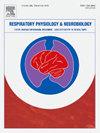Acrolein-induced oxidative and nitrosative stress and its impact on respiratory mechanics in mice assessed using the forced oscillation technique
IF 1.6
4区 医学
Q3 PHYSIOLOGY
引用次数: 0
Abstract
Acrolein exposure in the lung was studied to determine the effect of acrolein on airway responsiveness and pulmonary mechanics, as measured by the forced oscillation technique (FOT), under conditions of airway activation by methacholine (MCh), as well as with no activation, using the negative pressure-driven forced expiratory (NPFE) maneuvers to assess quasi-static lung compliance. Direct intratracheal acrolein was applied to C57BL/6 J male mice in dosages of 0 (saline vehicle-only) or 4 mg/kg, with FOT and NPFE assessments made 48 hr post-acrolein administration. Our results suggest that lipid peroxidation may be a primary factor in the observed attenuated response of resistance of the respiratory system (Rrs) to MCh (25 % decrease), potentially due to the alteration of the lipid bilayer that contains the transmembrane muscarinic receptors that respond to MCh. Furthermore, static lung compliance was significantly reduced in mice receiving acrolein. The product of lipid peroxidation, malondialdehyde (MDA), was confirmed in the bronchoalveolar lavage fluid (BALF) of the acrolein group to be significantly higher than the control groups (35 % increase). The nitrite concentration measured in the acrolein group BALF was consistent with elevated levels of nitric oxide (NO) (∼50 % increase), and perhaps peroxynitrite, which could be additional nitrosative stress factors promoting lipid peroxidation in our acute model of acrolein toxicity. Furthermore, the decrease in glutathione peroxidase (GPx) (52 % decrease) that we observed suggested a significant reduction in endogenous antioxidant capacity, with the oxidative stress associated with increased lipid peroxidation resultant from acrolein exposure. We conclude that the lipid peroxidation and decline in redox capacity due to nitrosative stress induced by acrolein could be an important factor in modulation of pulmonary mechanics, airway remodeling, and bronchial responsiveness.
用强迫振荡技术评估丙烯醛诱导的氧化和亚硝化应激及其对小鼠呼吸力学的影响
研究丙烯醛在肺中的暴露,以确定丙烯醛对气道反应性和肺力学的影响,通过强迫振荡技术(FOT)测量,在甲基胆碱(MCh)激活气道的条件下,以及没有激活的情况下,使用负压驱动的强迫呼气(NPFE)机动来评估准静态肺顺应性。以0(纯生理盐水)或4mg/kg剂量直接气管内注射丙烯醛给药C57BL/6J雄性小鼠,并在给药48小时后进行FOT和NPFE评估。我们的研究结果表明,脂质过氧化可能是观察到的呼吸系统(Rrs)对MCh的抗性反应减弱(降低25%)的主要因素,可能是由于含有对MCh有反应的跨膜毒蕈碱受体的脂质双分子层的改变。此外,服用丙烯醛的小鼠的静态肺顺应性显著降低。丙烯醛组支气管肺泡灌洗液(BALF)中脂质过氧化产物丙二醛(MDA)明显高于对照组(增加35%)。丙烯醛组BALF中测量的亚硝酸盐浓度与一氧化氮(NO)水平升高(约50%)一致,可能是过氧亚硝酸盐,这可能是我们急性丙烯醛毒性模型中促进脂质过氧化的额外亚硝化应激因子。此外,我们观察到谷胱甘肽过氧化物酶(GPx)的减少(减少52%)表明内源性抗氧化能力显著降低,氧化应激与丙烯醛暴露导致的脂质过氧化增加有关。我们得出结论,丙烯醛引起的亚硝化应激引起的脂质过氧化和氧化还原能力下降可能是调节肺力学、气道重塑和支气管反应性的重要因素。
本文章由计算机程序翻译,如有差异,请以英文原文为准。
求助全文
约1分钟内获得全文
求助全文
来源期刊
CiteScore
4.80
自引率
8.70%
发文量
104
审稿时长
54 days
期刊介绍:
Respiratory Physiology & Neurobiology (RESPNB) publishes original articles and invited reviews concerning physiology and pathophysiology of respiration in its broadest sense.
Although a special focus is on topics in neurobiology, high quality papers in respiratory molecular and cellular biology are also welcome, as are high-quality papers in traditional areas, such as:
-Mechanics of breathing-
Gas exchange and acid-base balance-
Respiration at rest and exercise-
Respiration in unusual conditions, like high or low pressure or changes of temperature, low ambient oxygen-
Embryonic and adult respiration-
Comparative respiratory physiology.
Papers on clinical aspects, original methods, as well as theoretical papers are also considered as long as they foster the understanding of respiratory physiology and pathophysiology.

 求助内容:
求助内容: 应助结果提醒方式:
应助结果提醒方式:


